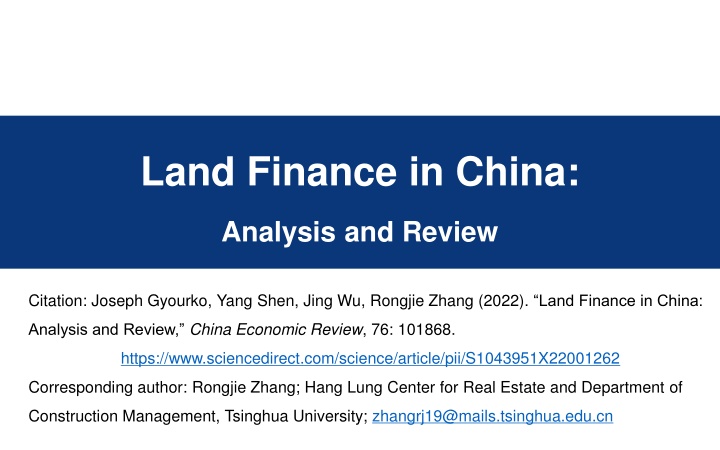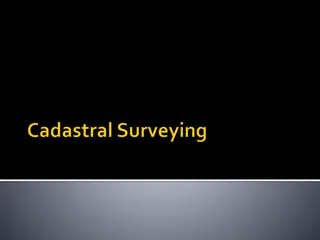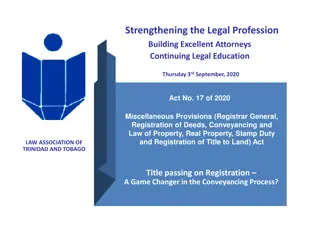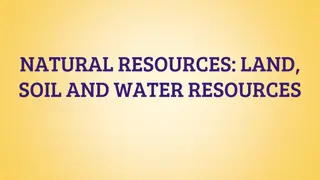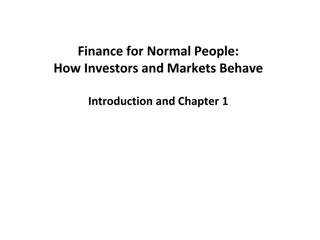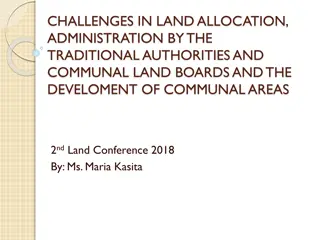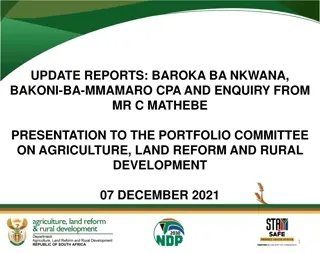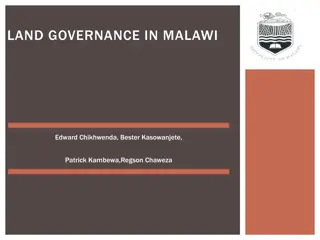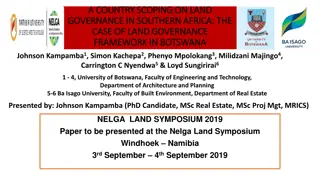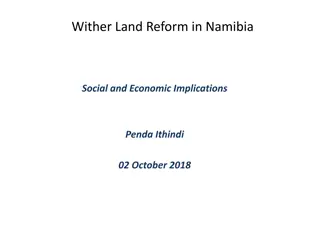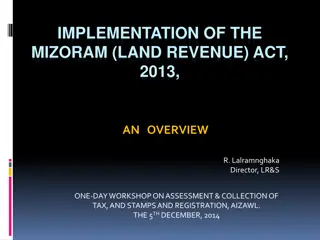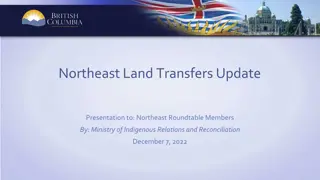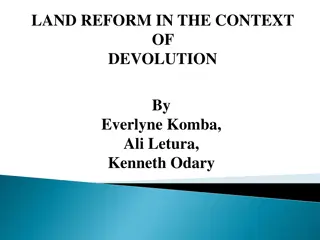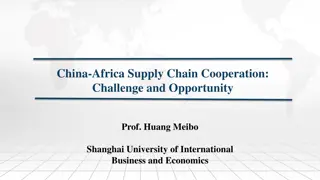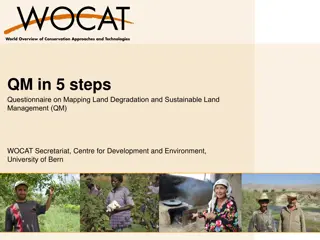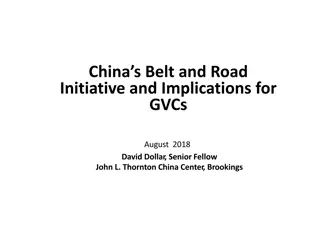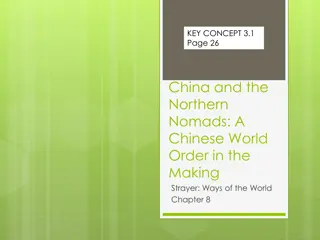Analysis of China's Land Finance System
This paper delves into the institutional underpinnings and sustainability of China's land finance system, highlighting its pivotal role in the country's economic development. It offers insights on the profitability, incentives, and challenges of the system, drawing from a comprehensive analysis of both macro- and micro-level data.
Uploaded on Mar 16, 2025 | 2 Views
Download Presentation

Please find below an Image/Link to download the presentation.
The content on the website is provided AS IS for your information and personal use only. It may not be sold, licensed, or shared on other websites without obtaining consent from the author.If you encounter any issues during the download, it is possible that the publisher has removed the file from their server.
You are allowed to download the files provided on this website for personal or commercial use, subject to the condition that they are used lawfully. All files are the property of their respective owners.
The content on the website is provided AS IS for your information and personal use only. It may not be sold, licensed, or shared on other websites without obtaining consent from the author.
E N D
Presentation Transcript
Land Finance in China: Analysis and Review Citation: Joseph Gyourko, Yang Shen, Jing Wu, Rongjie Zhang (2022). Land Finance in China: Analysis and Review, China Economic Review, 76: 101868. https://www.sciencedirect.com/science/article/pii/S1043951X22001262 Corresponding author: Rongjie Zhang; Hang Lung Center for Real Estate and Department of Construction Management, Tsinghua University; zhangrj19@mails.tsinghua.edu.cn
Conclusion Institutional Underpinnings Sustainability Introduction Essentials Motivation China s land finance system ( ), or local governments high reliance on urban land-related financing, is a key component of China s economic life Land finance has played an essential role in China s remarkable urban development Nevertheless, concerns about land finance s viability going forward are also growing The central govt s explicit statement of no land finance since 2017 The recent cooling down in housing markets in major cities It is critical for policymakers to understand the operation of the system and its costs, so that the ongoing reform can be made based on the best information possible China s land finance system can also provide valuable lessons for policymakers in other developing economies interested in govt-authorized land-based financing 2
Conclusion Institutional Underpinnings Sustainability Introduction Essentials This paper provides Many studies have been written about China s land finance system, but a comprehensive description and analysis of the whole system does not exist To fill this gap, this paper incorporates: Findings from the literature in both the economics field and political science, urban planning, and sociology Insights from influential studies published only in Chinese Descriptive analysis based on both macro- and micro-level data to provide a clearer understanding of several essential facts 3
Conclusion Institutional Underpinnings Sustainability Introduction Essentials This paper provides The analysis is organized around three key topics on the land finance system, with the pivotal role of profitability highlighted throughout Essentials of the System 1 The source and magnitude of profits Land Finance System s Profitability Sustainability Institutional Underpinnings 2 3 Incentives Why local govts need such profits? Preconditions Why land finance can generate profits? Costs & Risks Past perspective: The other side of profitability Feasibility Future perspective: Key challenges to profitability 4
Conclusion Institutional Underpinnings Sustainability Essentials Introduction Essentials of Land Finance System A self-reinforcing positive feedback system controlled by local govts 3. Local govts spend most of those funding on investments and/or firm subsidies, which improve and/or help attract more firms Local govts create 1. new urban LURs via acquiring rural land or repurchasing sold urban LURs 2. Local govts use the value arising from transferrable LURs to generate revenues from land sales or to help back debt issues infrastructure urban amenities Land-Backed Debts Economic Growth Firm Subsidies Urban land-use rights (LURs) Funding Source Expenditure Urban Amenity Infrastructure Development Land Sales Profits Local Govt 4. A more prosperous local area and/or one with a higher quality of life would have higher land prices, which can further enhance local governments land financing capacities 5
Conclusion Institutional Underpinnings Sustainability Essentials Introduction 1. Asset of Land-Use Rights The separation of urban land ownership and LURs since the 1980s On behalf of the State, local govts hold ultimate ownership of urban land, which is prohibited from trading LURs, as a bundle of property rights protected by law, can be transferred, mortgaged, and sold for profit (similar with the the leasehold estate in the west) Local govts cannot receive future benefits once the LUR is conveyed Local govts hold the LURs associated with new developable urban land acquired via the so-called land acquisition process New urban LURs are the base of the land finance system The gap between the market value and the acquiring cost of the new urban LURs (defined as profitability of land finance) matters for local govts 6
Conclusion Institutional Underpinnings Sustainability Essentials Introduction 1. Asset of Land-Use Rights New Urban Land (Rural-Urban Land Conversion) Compensation for Land Acquisition New Urban LURs Local Govts most important assets Urban Redevelopment (Existing Developable Land) 7
Conclusion Institutional Underpinnings Sustainability Essentials Introduction 1. Asset of Land-Use Rights Local govts acquired 62.34 trillion RMB of new urban LURs in 2004-2017 trillion yuan billion sq.m. 16 8 14 7 12 6 10 5 8 4 6 3 4 2 2 1 0 0 2004 2005 2006 2007 2008 2009 2010 2011 2012 2013 2014 2015 2016 2017 Rural Land Acquisition (left) Urban Land Repurchasing (imputed; left) Total Market Value (right) 8 Sources: authors calculations based on data released by the Ministry of Natural Resources
Conclusion Institutional Underpinnings Sustainability Essentials Introduction 1. Asset of Land-Use Rights Data on land acquisition cost are only available for early years Land acquisition costs have strong (and persistent) intercity variation Nearly developed areas, but far more expensive in cities with hot housing markets free in some less More information on local govts land acquisition costs during more recent years is called for Sources: authors calculations based on data released by the Ministry of Natural Resources 9
Conclusion Institutional Underpinnings Sustainability Essentials Introduction 2.1 Land-Sales Profits Local govts land-sales revenues reached 55.06 trillion RMB in 2007-2020 The huge revenues concentrate in major cities with hot housing markets 12 Trillion RMB Budgetary income of local government Land sales revenue: (Ministry of Finance) 10 Land sales revenue: (Ministry of land and resources) 8 6 4 2 0 2001 2002 2003 2004 2005 2006 2007 2008 2009 2010 2011 2012 2013 2014 2015 2016 2017 2018 2019 2020 Sources: authors calculations based on data released by the Ministry of Natural Resources and the Ministry of Finance 10
Conclusion Institutional Underpinnings Sustainability Essentials Introduction 2.1 Land-Sales Profits It is important to remember that the true (net) contributions of land sales only comes from the profits, instead of all the revenues Again, data on the net profit- revenue ratio are only available for early years The have strong intercity variation The ratio of the lowest quantile varied from 23% to 26%, but reached 60% in the top quantile net profit-revenue ratios Some local govts cannot realize as much land-related financing as the enormous gross land- sales revenues might suggest Sources: authors calculations based on data released by the Ministry of Natural Resources 11
Conclusion Institutional Underpinnings Sustainability Essentials Introduction 2.1 Land-Sales Profits From a broader perspective, following new LUR sales, real estate property developments and transactions bring substantial tax revenues to local govts Volume (billion RMB) Share in Real Estate Related Taxes Share in Total Tax Revenue Item 1.269 56.5% 16.8% 1. Transaction Based Real Estate Taxes 0.528 23.5% 7.0% 2. Stock Based Real Estate Taxes 0.451 20.1% 6.0% 3. Developer Based Real Estate Taxes 2.248 100.0% 29.7% Aggregated Real Estate Related Taxes 7.562 - 100.0% Total Tax Revenue In 2018, the total volume of land-related profits received by local govts, including both land-sales profits and real estate-related taxes, reaches 4 trillion RMB, or over 40% of total budgetary income at the local level 12
Conclusion Institutional Underpinnings Sustainability Essentials Introduction 2.2 Land-Related Debt Financing Before 2014: LGFVs land-related debt financing Local govts were prohibited from directly implementing debt financing, but were allowed (or even encouraged) to use Local Govt Financing Vehicles (LGFVs) to implement off-balance-sheet debt financing In June 2013, the outstanding debt borrowed by LGFVs accounted for 37.5% of the 10.89 trillion RMB total volume of local govt debt Local govts seldom provide urban LURs to LGFVs as their collateral in implementing debt financing activities Instead, local govts prefer using future land-sales profits as an implicit guarantee to support LGFVs debt financing (Liu & Xiong, 2020) Indirect empirical evidence: Ambrose, Deng, & Wu (2015), Mo (2018), Zhang, Liu, & Nian (2018) 13
Conclusion Institutional Underpinnings Sustainability Essentials Introduction 2.2 Land-Related Debt Financing Since 2015: Local govt bond and land finance Local govts are allowed to issue general local govt bonds and specific local government bonds , with the latter targeting infrastructure investments The local govt issuing a special bond can explicitly use its future land-sales profits to repay the bond A formal and legal linkage between land finance and local govts debt financing activities 7 Trillion RMB General Bonds 6.05 Special Bonds 6 5 4.36 4.36 4.17 3.84 4 3 2 Thus, the fluctuations of land sales profits may affect the yield spread on special bonds and/or their issuance volume No empirical evidence so far 1 0 2015 2016 2017 2018 2019 Sources: authors calculations based on data released by the Ministry of Finance 14
Conclusion Institutional Underpinnings Sustainability Essentials Introduction 3. Usage of Land-Related Funding Infrastructure investments Land finance has played a dominant role in supporting local govts infrastructure investments over the past two decades (Zhang & Xiong, 2020) Wang et al (2011): the breakdown of the funding sources of local govts urban infrastructure investments based on various official statistics suggests that land finance dominates all potential funding sources NAO: by the end of 2013, 34.5% of the 16.75 trillion RMB in local govt debt went to finance urban infrastructure investment, while another 24.4% went toward investments in intercity transportation infrastructure Ambrose, Deng, & Wu (2015): of all the corporate bonds issued by LGFVs, 53% list infrastructure investments as the designated usage 15
Conclusion Institutional Underpinnings Sustainability Essentials Introduction 3. Usage of Land-Related Funding Infrastructure investments Land finance has played a dominant role in supporting local govts infrastructure investments over the past two decades (Zhang & Xiong, 2020) An increase in land-sales revenues leads to a jump in local govts investments in infrastructure Empirical evidence: Zuo & Yin (2013), Wu et al (2014), Zheng et al (2014), Ding, Niu, & Lichtenberg (2014) Potential measurement error: all the analyses adopt land-sales revenues, instead of profits, as the proxy of local govts benefits from land finance 16
Conclusion Institutional Underpinnings Sustainability Essentials Introduction 3. Usage of Land-Related Funding Providing firm subsidies Implicit subsidy: low and stable industrial land prices Local govts implement the strategy of low-cost industrialization and high-cost urbanization in land supply (Fan, Mo, & Zhang, 2015; Tao et al, 2009) Local govts prefer to keep industrial land prices low to attract firms, which they believe will boost local GDP growth and bring in future tax revenues Fan, Mo, & Zhang (2015) and Zhao, Wang, & Gong (2017) construct theoretical models to provide a more formal explanation of such incentives Existing literature do not provide direct causal evidence of the relationship between high residential land prices and low industrial land prices - it is less clear how industrial land prices would respond if residential land prices/sales declined 17
Conclusion Institutional Underpinnings Sustainability Essentials Introduction 3. Usage of Land-Related Funding Providing firm subsidies Implicit subsidy: low and stable industrial land prices Explicit subsidy: firm tax subsidies Chinese local govts offer various types of firm tax subsidies Tax subsidies attract firm investment (Jia, 2014; Zhang et al 2021), boost exports (Chandra & Long, 2013; Girma et al 2009), and encourage R&D (Li & Zheng, 2016) The literature has not directly linked land finance with local governments land subsidies via causally identified empirical estimation The only empirical evidence from Zhang et al (2021): an exogenous positive shock to local governments land-sales revenues engenders significantly more tax subsidies to local firms and also reduces the intensity of tax collection 18
Conclusion Institutional Underpinnings Sustainability Essentials Introduction 4. Self-Reinforcing Positive Feedback Two-way effects: Local govts use the value arising from transferrable LURs of new urban land parcels to generate revenues from land sales or to help back debt issues Local govts spend most of those funding on infrastructure investments and/or firm subsidies, which either improve urban amenities or help attract more firms A more prosperous local area and/or one with a higher quality of life would have higher land prices (Roback, 1982), which, in turn, can feed on itself by further enhancing local govts land financing capacities Empirical evidence: Wu et al (2014); Zheng et al (2014); Guo & Shi (2018) The self-reinforcing cycle around land finance substantially boosts local economic growth Empirical evidence: Zhao, Wang, & Gong (2017); Tao et al (2010); Wu (2010); Wu et al (2014); Mo (2018) 19
Conclusion Institutional Underpinnings Sustainability Essentials Introduction Institutional Underpinnings of Land Finance Why Land Finance System Is Effective (so far)? 4 Preconditions Why Use Land Finance? 2 Incentives Monopoly power in land-usage conversion Profitability Shrinking budgetary funding sources Market preconditions (high & growing land prices) Profit Local Govt Enhance High autonomy Supply Volume in controlling urban land supply Incentives to pursue political promotion High autonomy in determining funding usage Funding Usage Self-reinforce 20
Conclusion Institutional Underpinnings Sustainability Essentials Introduction The Reason Why Using Land Finance Main Reason: most local govts face a gap between shrinking budgetary funding sources and growing spending needs due to the 1994 tax-share reform 100% Local govts, thus, have to seek off- Local Governments' Share in Fiscal Income Local Governments' Share in Fiscal Expenditure budgetary funding sources from land 90% finance (Lv & Wang, 2021) 80% But there is only limited evidence on 70% the causal relation between local govts 60% budgetary burdens and their land 50% finance reliance: Sun & Zhou (2013), 40% Wang et al (2020), Wang, Wu, & Wu 1990 Sources: authors calculations based on data released by the Ministry of Finance 1991 1992 1993 1994 1995 1996 1997 1998 1999 2000 2001 2002 2003 2004 2005 2006 2007 2008 2009 2010 2011 2012 2013 2014 2015 2016 2017 2018 2019 2020 (2021) 21
Conclusion Institutional Underpinnings Sustainability Essentials Introduction The Reason Why Using Land Finance Local political officers incentives to pursue political promotion may further enhance the first explanation by exacerbating local govts budgetary burdens GDP growth rate is the most critical indicators in determining local chiefs political careers (Jia, Kudamatsu, & Seim, 2015; Li & Zhou, 2005; Wu et al 2014) The ways to boost short-term GDP growth all rely on substantial local govt spending Empirical evidence: Li, Hong, & Huang (2013), Hsu et al (2017), Lu, Yao, & Wang (2021), Chen & Kung (2016) Some works also link land finance to government officials rent-seeking incentives Zhao et al (2020) and Fang et al (2021) find substantial impacts of China s anti-corruption campaign on local governments land-sales activities Nevertheless, no evidence exists that local government officials established the system of land finance mainly to create or enlarge rent-seeking opportunities 22
Conclusion Institutional Underpinnings Sustainability Essentials Introduction Preconditions of Land Finance Local govts monopoly power in the land-usage conversion The local govt is the sole entity that can legally implement rural-to-urban land conversions or adjust usage and zoning indicators of occupied urban land parcels The current landowner or LUR holder cannot expect a higher bid from a competitor The compensation price is calculated based on the current conditions of the land parcel E.g.: the compensation price for rural land parcel is based on its agricultural value (Ding, 2007) The local govt can implement compulsory land acquisition for public interest In practice, the local judiciary can determine the concept of the public interest, which can even be extended to the development of real estate projects (Nguyen, Duan, & Zhang, 2018) Thus, the local govts can control compensation to keep the acquisition costs low 23
Conclusion Institutional Underpinnings Sustainability Essentials Introduction Preconditions of Land Finance Market preconditions High land prices ensure a high absolute amount of land-sales revenues and land-backed borrowing, and the positive trend in land prices enables a local govt to buy low and sell high to generate great profit Constant-Quality Residential Land Price Index of 35 Major Cities City-level Annual Residential Land Price Growth, 2007-2017 10.00 9.00 8.00 7.00 6.00 5.00 4.00 3.00 2.00 1.00 0.00 Annual Growth Rate National East Middle West Sources: authors calculations based on data released by the Ministry of Natural Resources 24
Conclusion Institutional Underpinnings Sustainability Essentials Introduction Preconditions of Land Finance Local govts high autonomy in controlling urban land supply Based on the Land Use Master Plan , local govts create Land Use Annual Plan , which designates the annual quota of land conversion and land supply However, the constraint of the quota system can be softened in practice Two formal mechanisms permit local govts to seek additional quotas Between-jurisdiction: quota trade among local governments (Wang & Tao, 2009) Within-jurisdiction: obtain more land conversion quota after developing new farmland Local govts can choose to negotiate with a higher-level government Local govts typically can partially achieve their goals (Shao et al, 2018; Tan, 2014) Local govts could just choose to ignore the quota constraint In most cases, the punishment for breaking the quota of rural-to-urban land conversion or urban land supply is acceptably small (Liu, Zhao, & Song, 2017; Wang et al, 2020; Wei, 2015) 25
Conclusion Institutional Underpinnings Sustainability Essentials Introduction Preconditions of Land Finance Local govts high autonomy in land-related funding usage Since 2007, a local govt must include land-sales revenues in its govt-managed funds and use them under the list of qualified usages Type Item However, such regulation still Actual expenditur e-based Land acquisition compensation Infrastructure development on the sold land parcels Land-transfer business fee Farmland development fee Farmland development fees prepared for superior governments Affordable housing expenditure fee Urban construction Rural infrastructure construction State Land Funding Employee compensation of bankrupt or restructured state-owned enterprises Farmers social security Subsidies for land-expropriated farmers provides autonomy in determining the usage of land-related funding usage Regular fees can cover Urban most spending on urban infrastructure construction Free expenditur e items Repaying local govt bonds (since 2015) 26
Conclusion Sustainability Essentials Introduction Institutional Underpinnings Sustainability of the Land Finance System Future? Feasibility Past? Costs/Risks Market Perspective Misallocation of land resources Decreasing land-sales revenues/profits since 2017 Decrease Quantity Spatial Sustainability Profitability Fueling mispricing in housing market Decrease Institutional Perspective Increasing land acquisition costs due to policy changes Amplifying systematic risks Housing market risks Local govt debt risks PPP Not likely now Replacing Funding Sources Negative effects on rural development Property Tax REITs
Conclusion Sustainability Essentials Introduction Institutional Underpinnings Costs/Risks of the Land Finance System Misallocation of land resources Quantity perspective: local governments tend to oversupply land parcels when they have higher funding needs (Pan, Huang, & Chiang, 2015) Too much rural land is converted to urban usage: Cao, Feng, & Tao (2008), Lin & Yi (2011), Lin (2014), Ye & Wu (2014), Wang et al(2021) million sq.m. billion sq.m. Housing Inventory (right) Land Supply (left) Housing Starts (left) The increasing residential land supply affect the housing market 3.0 500 would further 450 2.5 400 350 2.0 The supply, housing starts, and housing inventory sharply increased during the stimulus period residential land 300 1.5 250 200 1.0 all 150 100 0.5 50 0.0 0 2007 Sources: authors calculations based on data released by the National Bureau of Statistics 2008 2009 2010 2011 2012 2013 2014 2015 2016 28
Conclusion Sustainability Essentials Introduction Institutional Underpinnings Costs/Risks of the Land Finance System Misallocation of land resources Spatial perspective: Local govts are more inclined to acquire and convert land parcels with higher profit potential, but not necessarily parcels that need to be redeveloped or urbanized Land finance has been a major driver of the intensive urban sprawl in many Chinese cities (Liu et al, 2018; Yew, 2012; Yue, Liu, & Fan, 2013) Anglin et al (2014) suggests that the land finance system results in cities with larger areas but less developed city centers in China than would be optimal Local govts may also choose to intentionally under-supply residential land in order to hike land prices (Du & Peiser, 2014; Du, Thill, & Feng, 2014) 29
Conclusion Sustainability Essentials Introduction Institutional Underpinnings Costs/Risks of the Land Finance System Fueling mispricing in housing markets Land finance is highly related to the housing price surge in China Land finance accounts for about 40% of housing price variation (Wang & Hou, 2021) Only a few studies partly admit the positive effect from a fundamental value perspective Zheng et al (2014), Wu et al (2014), Wu, Feng, & Li (2015) More believe that local govts strong incentives to pursue land finance fuel mispricing in the housing market and exaggerate housing market risks Local govts can intentionally implement intervention policies that fuel the housing market to expand land-sales revenues: Han & Kung (2015), Mei & Wen (2020), Hu & Qian (2017) Land finance can also affect market participants expectations and behaviors, which would increase speculation demand: Pan, Huang, & Chiang (2015), Zhang, Geltner, & de Neufville (2018) 30
Conclusion Sustainability Essentials Introduction Institutional Underpinnings Costs/Risks of the Land Finance System Amplifying systematic risks Negative effect of a housing market correction on local govt investments The overall effect of land finance is to increase the amplitude of the macroeconomic cycle fluctuations by 12.6% (Guo, Liu, & Zhao, 2015) Nevertheless, He (2020) and Wang, Wu, & Wu (2021) suggest that local govts may implement a pro-cyclical residential land supply policy to dampen economic fluctuations Risks associated with burgeoning local govt debts Land finances generate a strong correlation between housing market risks and local govt debt risks (Pan et al, 2017), which are perceived as two potential systematic risks in China Only limited quantitative evidence on such a linkage: Ambrose, Deng, & Wu (2015) 31
Conclusion Sustainability Essentials Introduction Institutional Underpinnings Costs/Risks of the Land Finance System Negative effects on rural development The low compensation substantially reduces the benefits to current rural landowners, resulting in several negative consequences Landless farmers can experience a long-term welfare loss if they do not receive enough compensation (Ong, 2014; Zhou, 2007) Dissatisfaction with inadequate compensation has become a major driver of social instability in rural areas (Ding & Lichtenberg, 2011) The hazards of even partial expropriation significantly reduce farmers incentives to provide long-term inputs to their farmland (Jacoby, Li, & Rozelle, 2002). The great gap between urban land value and compensation for requisitioned rural land also leads to the phenomenon of so-called small property rights housing (He et al, 2019; Liu, Wong, & Liu, 2012) and urban villages (Wang, Wang, & Wu, 2009; Zheng et al, 2009) 32
Conclusion Sustainability Essentials Introduction Institutional Underpinnings Costs/Risks of the Land Finance System Two remaining issues on the research agenda Work is needed to better quantify the welfare change arising from the system Presently, directly comparing the costs/risks of land finance with its benefits, which should serve as the starting point of the future reform of the land finance system, remains difficult A few studies suggest the costs of land finance now could outweigh their benefits (Liu et al, 2020; Guo & Jiang, 2019; Geng et al, 2018), but no consensus based on standard economic models and empirical estimation strategies exists yet Between-city variation in costs is important in designing city-specific reform policies Local govts land finance-related incentives may mainly generate opposite effects on the local housing market though different channels The effect on systematic risks is also determined by local govts financing strategies and debt structures 33
Conclusion Sustainability Essentials Introduction Institutional Underpinnings Feasibility of the Land Finance System Market perspective: land-sales revenues/profits are trending down following the changing anticipation of the housing market since 2017 Housing is for living in and not for speculative investment ( ) has become the central govt s guiding principle in urban housing sector development since 2017 Local govts issued a series of market intervention policies to rein in house price surges The housing market does reflect the effect of these cooling policies Institutional perspective: cost of land acquisition are increasing due to a series of recent policy changes, which reduces the net profit of land finance 34
Conclusion Sustainability Essentials Introduction Institutional Underpinnings Feasibility of the Land Finance System Market perspective: land-sales revenues/profits are trending down following the changing anticipation of the housing market since 2017 Institutional perspective: cost of land acquisition are increasing due to a series of recent policy changes, which reduces the net profit of land finance Local govts are losing their monopoly role in rural-to-urban land conversions Since 2020, a village is allowed to directly sell or lease LURs associated with rural developable land to external entities or individuals following specific procedures Land acquisition costs, especially reimbursement costs, are also increasing In 2013, the central govt imposed stricter regulations on the procedures for land acquisition and higher standards on compensations to current owners Some researchers point out that the central govt is also imposing stricter regulations on the urban land conversion and supply quota system in general (Liu, Zhao, & Song, 2017) The ongoing fundamental changes in both institutional factors and market conditions indicate decreasing feasibility of the land finance system 35
Conclusion Sustainability Essentials Introduction Institutional Underpinnings Feasibility of the Land Finance System If the system of land finance were to become less sustainable, that begs the very important question of what would replace it as a funding source for local govts Surge of public-private partnership (PPP) projects since about 2014 The unprecedented increase within such a short period appears to have led to over-adoption or even abuse of PPP projects (Wang et al, 2020; Zhang et al, 2019) Attempt to develop REITs in the urban infrastructure sector since 2020 The first batch of nine REITs were issued in June 2021 Debates on property tax (Liu, 2019; Zhang & Hou, 2016; Zhu & Dale-Johnson, 2020) The property tax is only officially levied in Shanghai and Chongqing for a limited housing stock In 2021, the central govt explicitly stated that more cities would soon join the pilot program The possibility of any or all of these sources entirely replacing the dominant role of land finance in the foreseeable future seems unlikely 36
Conclusion Sustainability Essentials Introduction Institutional Underpinnings Concluding Remarks The self-reinforcing land system brings remarkable profits (both land sales profits and land-backed debts) for local govts during the past decades Such a high profitability not only ensures the success of the system in the past, but also doubts the system s sustainability in the future Land-Backed Debts Economic Growth Firm Subsidies Urban land-use rights (LURs) Funding Source Expenditure Urban Amenity Infrastructure Development Land Sales Profits Local Govt 37
Conclusion Sustainability Essentials Introduction Institutional Underpinnings Concluding Remarks For policymakers in China, the analysis and review provide insights into the ongoing reform of the land finance system The critical challenge is the decreasing feasibility of land finance in funding urban infrastructure investment due to its lower profitability Potential policy options: Restructuring the 1994 tax-sharing agreement, but doing so would likely have spillover effects on the entire economy Reducing infrastructure spending now that urbanization has nearly occurred The rise of infrastructure REITs as an alternative funding source would help take pressure off local governments 38
Conclusion Sustainability Essentials Introduction Institutional Underpinnings Concluding Remarks For policymakers in other developing or transitional economies interested in implementing govt-authorized land-based financing, the major takeaway is the importance of profitability in the system The success of the land finance system in China (so far) relies on its profitability, which also serve as crucial preconditions if policymakers plan to replicate the land finance system in their countries The institutional underpinnings enabling local govts to keep the costs of acquiring LURs at a relatively low level A rising trend in urban land prices until recently Local govts spending activities that further fuel future urban land price Policymakers must also always keep an eye on the potential costs/risks 39
Conclusion Sustainability Essentials Introduction Institutional Underpinnings Concluding Remarks For academic researchers interested in China s land finance system, this review provides several valuable research topics An integrated framework that can quantify both the benefits and costs of the land finance system and, thus, its overall role in China s economy and social development is of great importance Much more theoretical and empirical evidence is needed on how the land finance system affects local govts borrowing capacities and debt risks Considering the pivotal role of profitability in the land finance system, we surely need a more thorough understanding of the cost side to the creation of LURs 40
THANKS Land Finance in China: Analysis and Review Citation: Joseph Gyourko, Yang Shen, Jing Wu, Rongjie Zhang (2022). Land Finance in China: Analysis and Review, China Economic Review, 76: 101868. https://www.sciencedirect.com/science/article/pii/S1043951X22001262 Corresponding author: Rongjie Zhang; Hang Lung Center for Real Estate and Department of Construction Management, Tsinghua University; zhangrj19@mails.tsinghua.edu.cn 41
